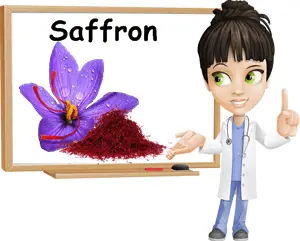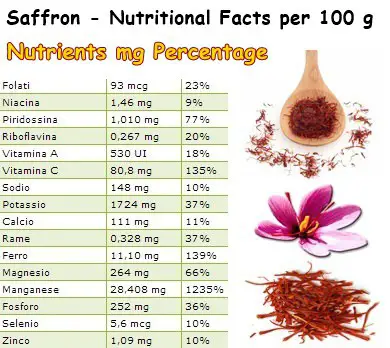This sun-loving spice is the domesticated progeny of the wild saffron and highly prized both as a spice and as an herb. Saffron is actually the stigma of the lavender saffron flower, scientifically known as Crocus sativus. This silk-like, bright red spice owes its unique flavor to countless volatile oils and its bright color to strong alpha and beta-carotenes, making it an excellent food for a good vision and eye health.
Also, saffron boasts an impressive vitamin and mineral content with great health health benefits for heart, muscles and bones.
It is an extremely rich source of manganese, iron, magnesium, copper and phosphorus, potassium, vitamins C and A and B vitamins, nutrients with bone, muscle, eyesight and cardiovascular benefits as well as impressive antibacterial and antioxidant properties. The unique color of the spice is indicative of the presence of a high content of zeaxanthin, a carotenoid known to promote retina health.

How is saffron made?
The spice saffron is obtained from picking the bright red or orange ends of the saffron flower pistils, also known as stigmas. Domesticated culinary saffron is also referred to as saffron crocus. It is both a spice and an herb with strong medicinal properties. Although it contains both alpha and beta-carotene, two potent natural antioxidants and coloring agents, saffron actually owes most of its bright red pigment to a special carotenoid called alpha-crocin. According to several studies, the crocins in saffron protect nerve cells from free radical damage and promote nerve regeneration.
Chemicals in saffron
The distinct flavor of saffron comes from a combination of volatile oils including: safranal, cineol, pinene, borneol, geraniol, limonene, p-cymene, linalool and terpinen-4-ol. Most volatile oils impart great anti-inflammatory and soothing properties to saffron as well as represent the source of the taste and unique flavor profile of the spice. Safranal is actually a derivative of zeaxanthin, a carotenoid with potent antioxidant properties. Alpha-carotene, beta-carotene, lycopene and safranol, all major carotenoid components of saffron, are responsible for the impressive antiseptic, digestion-soothing, heart-burn relieving, anti-inflammatory and antioxidant activity of the spice.
Nutrition facts and health effects of Saffron
Saffron and pregnancy
Traditional medicine practices encouraged saffron consumption even in pregnant women. Although you can add one or two strands of saffron to a glass of milk every now and then, it is best to consume all variety of spice or herb with moderation when pregnant. Spices and herbs, even stomach-soothing ones, may promote uterine contractions which may cause pregnant women to miscarriage. For this reason pregnant women are advised to keep their spice and herb intake low. But most important, talk to a doctor before introducing new foods into their diet, especially if said foods are culinary herbs or spices.

Other health effects and benefits of Saffron
As mentioned above, saffron is a rich source of carotenoids, as suggested by its bright, intense red-orange pigment. Zeaxanthin, an antioxidant carotenoid found in saffron, contributes greatly to eye health. Zeaxanthin is an antioxidant from plant sources and a physical component of the macula lutea, a central part of the human retina.
A diet rich in saffron, paprika, bell peppers, corn and other zeaxanthin-rich foods is pivotal for a healthy macula lutea and plays a definitive role in preventing vision degradation in the form of macular degeneration (loss of central vision). Zeaxanthin basically adds up in the center of the retina where it forms a filtering point for free radicals from blue light.

Saffron boasts an incredibly high manganese content (1235% of the RDI, recommended daily intake for 100 g of the spice) as well. Manganese is an antioxidant-mineral which protects cells from damage caused by the infamous free radicals. By preventing cell damage from accumulating and disrupting basic DNA structures, antioxidants protect against chronic diseases such as cancer or cardiovascular disease. Vitamin C works in a similar manner.
Saffron provides 135% of the RDI of vitamin C, a powerful antioxidant, antibacterial and anti-inflammatory. Having great amounts of vitamin C in your system efficiently prevents wrinkles, reduces the frequency, duration and severity of colds as well as inflammation, a condition associated with all forms of chronic disease.
Saffron provides significant amounts of B vitamins as well. Folate (23%), pyridoxine (77%) and riboflavin (20%) increase the efficiency with which our body makes energy from food and promote both muscle and nerve health. In addition to this, saffron has a beneficial action on heart health. With 1724 mg of potassium, accounting for 37% of the RDI, saffron helps reduce high blood pressure and regulates body fluids.
Good to know: during and after distressing episodes of diarrhea, it is best to supply the body with potassium, magnesium and some sodium. These are dietary minerals and electrolytes and help the body recover after severe dehydration caused by diarrhea or vomiting. They help restore fluid balance and normal cardiovascular and muscle function. Find out more about what to eat when you have diarrhea.
Saffron also promotes strong, healthy bones and good muscle tone as a result of its high magnesium content (66%). Magnesium increases the absorption of calcium in bones (not elsewhere) and ensures the good functioning of muscles such as the heart. With 139% of the RDI of iron, saffron makes an excellent spice for anyone dealing with anemia as a result of iron deficiency. Selenium and zinc in saffron promote thyroid gland health and support immunity. For more information on vitamins and minerals, go to the vitamins and minerals page in the menu above.
Conclusion
Although it is meant to be consumed in trace amounts, as seasoning for food, saffron remain a healthy option worth including in our diet. Remember however to always check for quality standards as well as authenticity when buying the spice. Not all products labeled saffron are actually saffron, but look-alike spices meant to imitate the color and, to a certain extent, the flavor of the real spice. Also, while saffron is a source of several wonderful properties and health benefits, know that in the amounts it is meant to be consumed, its nutritional input and health effects are minimal.
